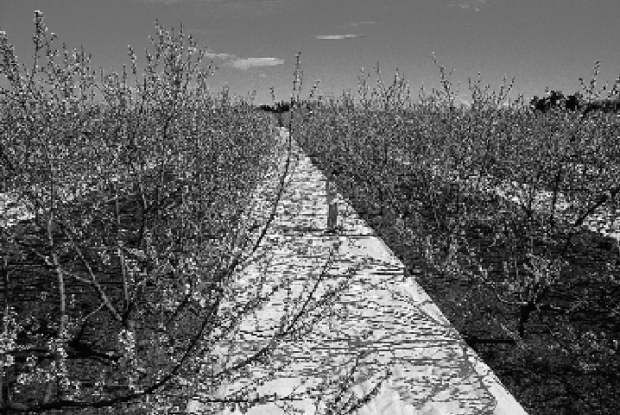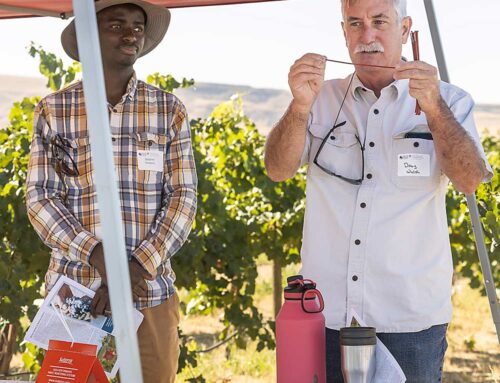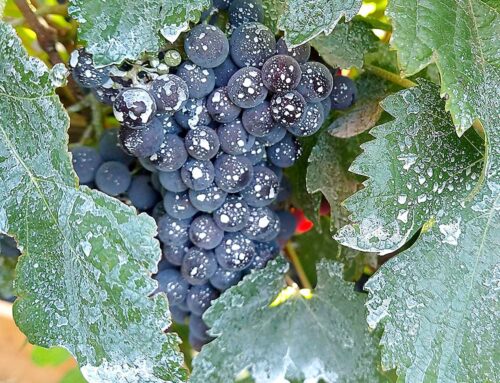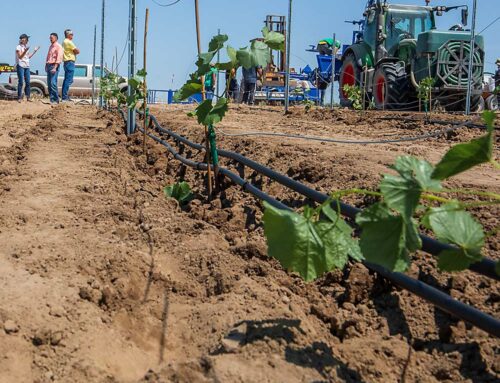
Research shows that the bright canopy environment helps repel Western flower thrips in nectarine orchards when Extenday is used during bloom.
A reflective fabric from New Zealand designed to improve light within tree fruit and grape canopies is creating quite a buzz among growers. Initial public and private research trials show the material is living up to its promises of improving fruit color and advancing maturity. The material, called Extenday, was developed and patented by Jonathan Toye, a former horticulture researcher for the New Zealand government. Toye has sold Extenday since the late 1990s, recently expanding his market to include the United States.
While working for the government in the mid-1980s, he studied the use of silver, reflective material to increase persimmon fruit quality and size, putting the material under the trees after bloom and keeping it in the orchard until harvest. He saw a big increase in fruit size in his trials. “I remember thinking, hmmm, that’s interesting,” he said in regards to the research results. He left governmental service in 1994 to further develop the reflective material concept.
Toye observed while doing research and development work that the silver material cooled soil temperatures if it was used early in the season during bloom and acted as a direct light reflector instead of a diffuse light reflector. What Toye came up with in his research was a tough, reflective mulch ground cover that has applications in a variety of fruit, from apples to mangos to grapes.
Timing
The reasons for use and timing of application of Extenday are different in each fruit crop, he explained. Some growers use Extenday to improve color, fruit finish, and sweetness. Others are interested in advanced and more uniform fruit maturity. Some are looking to increase fruit size or reduce fruit damage from certain pests. Most New Zealand wine grape growers use the material to improve wine quality.
Toye explained that most orchardists in New Zealand move the material between blocks of different crops and varieties. For example, they might use it to promote size of Gala apples, move it to their Rainier cherry block for color, and then move it again to color late-season apple varieties like Cripps Pink and Granny Smith. For color, the material is put out two to four weeks before harvest, and for size and sweetness, it is set out during bloom and left in place until harvest.
When Extenday is applied before bloom, research shows that the bright light within the canopy acts as a repellant to Western flower thrips. Research data also shows that Extenday helps reduce populations of the apple leaf midge, an insect common in New Zealand, by acting as a barrier to the soil where they pupate.
Western flower thrips
Research conducted by the Horticulture and Food Research Institute of New Zealand showed that Extenday fabric was as effective as soft pesticides (spinosad, abamectin, and pyrethrum) in reducing Western flower thrips in nectarines in an integrated pest management program. None of the treatments, however, were more effective than the standard control of tau-fluvalinate and chlorpyrifos, and would require supplementary control measures to meet harvest quarantine standards in New Zealand.
“When you put it out and for how long depends on what you want to accomplish,” he added. Costs per acre vary depending on fabric width and whether every row or every other row is covered, according to Extenday dealer Roger Wilson of Wilson Orchard & Vineyard Supply in Yakima, Washington. Generally, costs range from $1,200 to $3,000 per acre. The fabric is guaranteed to last 30 sun months; most growers are able to use the material for about five years. G.S. Long Company, Inc., of Yakima is also a supplier.
WSU research
WSU research Dr. Matt Whiting, Washington State University research horticulturist, began studying Extenday last season in Bing cherries, comparing fruit grown with and without the reflective fabric. “There were differences in the two treatments,” he said, adding that he observed improved vegetative growth, larger trees, higher numbers of shoots, larger trunk growth, and greener leaves in the Extenday treatment. “Higher growth rates and final fruit size occurred earlier in the year in the Extenday rows compared to the no treatment. The Extenday fruit weren’t any larger, but they got larger faster.”
Whiting said the most distinct response from the reflective material was the advancement of maturity. Bing cherries in the Extenday treatment ripened four to six days earlier than Bings without the material. He put the material on at full bloom and left Extenday in the orchard through harvest. “We already know what improved light does within a canopy,” he said, adding that light plays a major role in flower induction. “And we know that mulches help conserve soil moisture.”
Storage
But an “unexpected and interesting” benefit he discovered was that the treated cherries held up better in storage. Fruit was firmer and had higher Brix after three weeks in storage than the control fruit. “Firmness and sugar levels didn’t break down in storage.” “I didn’t see anything negative about the material,” he added. “The worst part of using Extenday is that it makes the orchard so bright—you definitely need sunglasses.” In the coming season, Whiting plans to study the storage aspect of using Extenday as well as conduct an economic analysis of the material to quantify fruit quality and yields.
“I know that the material is expensive, especially compared to the silver Mylar material used for coloring.” He will also use the material under the same trees during bloom in the second year of study to see if there are yield and return flowering differences. Whiting does worry about inducing stress in the trees, particularly from high temperatures and bright light within tree canopies. But so far, he hasn’t observed any signs of stress. Extenday has caught the eye of the Washington Tree Fruit Research Commission, he said, adding that the Research Commission plans to study the reflective fabric in apple orchards.






Leave A Comment